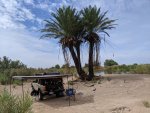roving1
Well-known member
At some point I would like to upgrade to a wedge camper top like a Super Pacific or a GFC unit. Until then I really wanted to upgrade to a 12V fridge for longer term travel but also not really mess with a seperate house battery and battery isolation system. I also in the medium term would like to ditch my CVT RTT and get something like a hard/soft shell pop up like a Free Spirit Recreation high country for easier set up. So I wanted to keep the roof clear for either of the above future uses.
So being a small regular cab pickup there are not a lot of options for where to put stuff. I also wanted to keep it simple and cheap and keep most of the components near to and under the hood. I also wanted somewhere between 150-200 watts to get better performance under marginal solar conditions.
So I settled on two Lensun 80 watt panels as they were the perfect size to just barely fit on the somewhat weird hood shape of the Tacoma. Upgrade the battery to 105AH East Penn/Napa group 31 AGM and a Victron 75/15 MPPT solar controller.
One panel would have fit such that I could have just VHB taped it to the hood but no way for two. One could have went on the roof as well but I wanted to leave that open for the above reasons. I also wanted it to be easily removable so I can park in the shade and extend the panels out to the sun or be able to angle the panels toward the sun in winter. So I came up with a system of using 1/4"x1" aluminum flat stock with foam weatherstripping on the bottom with latches riveted to it and the hood. The flat stock is under tension and wants to compress the foam towards the hood making it a very solid system without putting any stress on the panels themselves. The panel is VHB taped to the top of the flat stock in addition to zip ties for a physical connection backup. The panels have the same foam strips every 6 inches or so to have an air gap under the panels for cooling and to keep the panels from fluttering on the hood. So far the system works well and does not move or flutter at 80+ on the freeway.
The first gen Tacoma is known to not have the most robust battery shelf on the fender apron and has been known to sag with dual battery systems added. I am hopeful I can get away with this because I replaced a 40 something pound battery with a 60 something pound battery vs the 100-130 plus most dual battery systems would be in the same location. I thought long and hard about a 2nd Lithium battery but this just makes so much more sense and avoids so much more complicated wiring. My starting battery needed replacing anyways so all in all even though it's AGM it was the lightest simplest solution.
For now the MPPT controller is located in the engine bay "waterproofed" with a silicone reusable food bag zip tied around the wires. We will see how it goes. I really do not want to run 4 10GA wires through the firewall which makes very little sense since this system is all on and under the hood otherwise. Also with not much room in the regular cab it would probably get mounted lower down somewhere where it would be likely to flood out stuck in a mud puddle. Plus its better for the controller to have shorter wires and be the same temp as the battery. The reg cab has really huge temp swings particularly in winter where the cab might be 70 with the sun while its 20 ambient under the hood. At any rate it's a pretty spacious relatively cool engine bay. I am willing to risk the 80 buck controller to try out this setup just for the sake of simplicity for now.
As an aside when I was mocking up the system on sunny days where the car had not been driven for days and the amount of finger searing heat the sun and panels make on the hood even with a 1/2"air gap was amazing. I don't have infrared gun data to back it up but there is no way the engine heat would ever make the panels any hotter than they already get from the sun. Any worry about engine heat affecting the panels is now totally wiped from my mind as hot as these things get on their own.
So far it works great and on even really crappy overcast days it will pull 20-40 watts and 1-3 amps so even in the worst case scenario it will usually get the battery up to absorb and then float charge either every day or every other day with no engine running. As a sort of torture test I filled a cooler full of warm beer and set it to 34F with the battery at 50% charge followed by 3 days of rain and by the third day it had dug itself out of the hole and was float charging with no clear sunny days. So should be fine for normal use.
I have a 12v jump pack plus a manual transmission so I am pretty comfortable with the safety margin of still being able to start the vehicle if something goes wrong with the system.
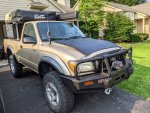
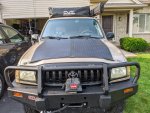
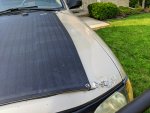
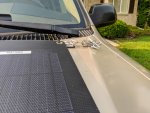
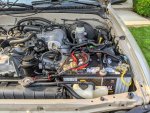
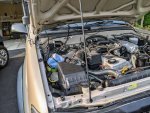
So being a small regular cab pickup there are not a lot of options for where to put stuff. I also wanted to keep it simple and cheap and keep most of the components near to and under the hood. I also wanted somewhere between 150-200 watts to get better performance under marginal solar conditions.
So I settled on two Lensun 80 watt panels as they were the perfect size to just barely fit on the somewhat weird hood shape of the Tacoma. Upgrade the battery to 105AH East Penn/Napa group 31 AGM and a Victron 75/15 MPPT solar controller.
One panel would have fit such that I could have just VHB taped it to the hood but no way for two. One could have went on the roof as well but I wanted to leave that open for the above reasons. I also wanted it to be easily removable so I can park in the shade and extend the panels out to the sun or be able to angle the panels toward the sun in winter. So I came up with a system of using 1/4"x1" aluminum flat stock with foam weatherstripping on the bottom with latches riveted to it and the hood. The flat stock is under tension and wants to compress the foam towards the hood making it a very solid system without putting any stress on the panels themselves. The panel is VHB taped to the top of the flat stock in addition to zip ties for a physical connection backup. The panels have the same foam strips every 6 inches or so to have an air gap under the panels for cooling and to keep the panels from fluttering on the hood. So far the system works well and does not move or flutter at 80+ on the freeway.
The first gen Tacoma is known to not have the most robust battery shelf on the fender apron and has been known to sag with dual battery systems added. I am hopeful I can get away with this because I replaced a 40 something pound battery with a 60 something pound battery vs the 100-130 plus most dual battery systems would be in the same location. I thought long and hard about a 2nd Lithium battery but this just makes so much more sense and avoids so much more complicated wiring. My starting battery needed replacing anyways so all in all even though it's AGM it was the lightest simplest solution.
For now the MPPT controller is located in the engine bay "waterproofed" with a silicone reusable food bag zip tied around the wires. We will see how it goes. I really do not want to run 4 10GA wires through the firewall which makes very little sense since this system is all on and under the hood otherwise. Also with not much room in the regular cab it would probably get mounted lower down somewhere where it would be likely to flood out stuck in a mud puddle. Plus its better for the controller to have shorter wires and be the same temp as the battery. The reg cab has really huge temp swings particularly in winter where the cab might be 70 with the sun while its 20 ambient under the hood. At any rate it's a pretty spacious relatively cool engine bay. I am willing to risk the 80 buck controller to try out this setup just for the sake of simplicity for now.
As an aside when I was mocking up the system on sunny days where the car had not been driven for days and the amount of finger searing heat the sun and panels make on the hood even with a 1/2"air gap was amazing. I don't have infrared gun data to back it up but there is no way the engine heat would ever make the panels any hotter than they already get from the sun. Any worry about engine heat affecting the panels is now totally wiped from my mind as hot as these things get on their own.
So far it works great and on even really crappy overcast days it will pull 20-40 watts and 1-3 amps so even in the worst case scenario it will usually get the battery up to absorb and then float charge either every day or every other day with no engine running. As a sort of torture test I filled a cooler full of warm beer and set it to 34F with the battery at 50% charge followed by 3 days of rain and by the third day it had dug itself out of the hole and was float charging with no clear sunny days. So should be fine for normal use.
I have a 12v jump pack plus a manual transmission so I am pretty comfortable with the safety margin of still being able to start the vehicle if something goes wrong with the system.






Last edited:








